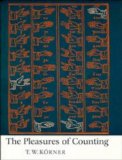The Pleasures of Counting is a book about people working with mathematics and challenges they have faced. The book has 544 pages with a total of 19 chapters and 3 appendices. It contains a lot of material and is split into five parts: The uses of abstraction, Meditations on measurement, The pleasures of computation, Enigma variations, and The pleasures of thought.
It addresses history, short biographies, mathematical theories, physics, biology, to name some. Topics touched upon are: Finding the source of a cholera outbreak, effects of medicine, submarines and convoys during World War I, production of ammunition, using radar, hitting (moving) aircrafts, attacking submarines from aircrafts during WWII, the early days of operational research, body mass and metabolic rate in animals, dimensional analysis in physics, properties of light, boat anchor design, Einstein's theory of relativity, weather prediction, turbulence, analysing the causes of war, measuring the length of coast lines, blood flow in vessels, pencil-and-paper vs. calculator, railroad problems during WWI and WWII, politics and argumentation regarding a new calendar, railways and safety, cryptology, the Enigma enciphering machines during WWII, code makers and code breakers during WWII, the RSA encryption system, survival of generations, epidemics and fish harvesting, mathematics as a career.
Every subject treated in the book is in some way related to mathematics. Most of the mathematics, however, are simple equations and back-of-the-envelope considerations. But many mathematical disciplines are touched upon, some of them being: Gathering and interpreting data, first and second order linear differential equation, trigonometry, curve-fitting using polynomials, Taylor expansions, numerical integration, the differentiability of functions, probability theory, fractals, number representations, Euclid's algorithm, Fibonacci numbers, maximum flow in networks, sorting and finding the largest number, roots and inequalities for second-degree polynomials, Stirling's estimate of , degrees of infinity, Alan Turing and the Entscheidungsproblem, substitution/rotation ciphers, elemental number theory, error-correcting codes, general logic and deduction, foundations of mathematics.
Many exercises are found throughout the book. They vary from discussion-type exercises,
Think carefully about the arguments against convoy given above. Which seem to you valid, which invalid and which partially valid? Give your reasons. Are there any other arguments for or against which ought to have been considered?
to applied mathematics (part of a larger exercise),
Suppose that we can produce merchant ships at a rate (ships per unit time) and that we lose merchant ships at a rate (ships per ship afloat per unit time). Explain briefly why, with this model, the size of our fleet is governed by the differential equation
and deduce that
where is the size of the fleet when .
to more pure-mathematics exercises (also part of a larger exercise),
Let be the integers between and which are coprime to . If is coprime to explain why is coprime to and there is exactly one integer between and such that . Explain why is coprime to .
Most of the mathematical exercises are formulated as “show that the solution of the equation is …” instead of “find the solution of the equation”. This makes it possible for the reader to skim over most exercises and get a feel for the mathematics involved without actually spending a lot of time solving (or trying to solve) the exercises.
For every subject in the book, a lot of references are provided if the reader wishes to know more. In fact, the bibliography contains no less than 264 entries. Furthermore, one of the appendices is named “Further reading” and contains 14 pages of well-founded book recommendations. These recommendations is a wonderful aspect of the book.
The book is well-written and has a nice layout. It has an excessive use of footnotes for my taste, though (or are they called sidenotes when placed along the margin?). Many pages contain several footnotes and they break your reading flow way too much.
Would I recommend it? Yes, I would, to someone having some mathematical interest and ability. The book treats so many topics that you are bound to enjoy at least some of it. In the preface of the book the author writes that it is meant for “able school children of 14 and over”. Perhaps someone that young would enjoy reading the book, but I would recommend “pre-university or first year university level”, as the book itself writes on the back cover.
Apart from many applications of mathematics, most chapters contain a lot of background information including politics, historical events, relations between the individual characters, and so on. At least half of the book, I would say, is this kind of background information. It was included, I think, to not only focus on applications of mathematics, but also to present the persons behind the mathematics in a historical, cultural and political context.
This history book-type narrative was too much for me, however. In hindsight I wish that I skimmed each chapter and only read it if it seemed sufficiently interesting. If you are historically interested you may enjoy all of it, though.
Book facts:
- Author: Thomas William Körner.
- Book title: The Pleasures of Counting.
- Publication year: 1996.
- Publisher: Cambridge University Press.
- ISBN: Paperback 0521568234, hardback 052156087X.
